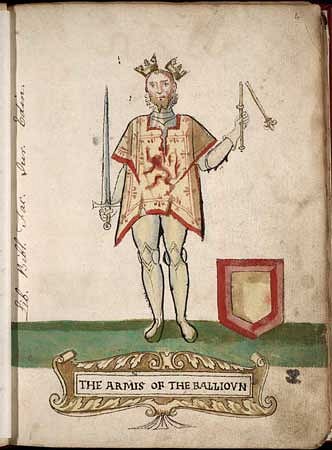
John Balliol ruled as the king of Scotland from 1292 to 1296 CE. He was supported by Edward I of England (r. 1272-1307 CE) in the competition to find the successor to the heirless Alexander III of Scotland (r. 1249-1286 CE), a process known as the Great Cause. John's reign came to a swift end in 1296 CE when Edward I decided to conquer Scotland. The Scottish king was publicly stripped of his royal title and insignia, hence his nickname of Toom Tabard ('Empty Coat'). When the Scots fought back against English oppression, they chose a new king, Robert the Bruce (r. 1306-1329 CE). John, meanwhile, was confined in the Tower of London and then exiled to France where he died on his family estate in Picardy in 1313 or 1315 CE.
Early Life & Family
John II de Balliol was born c. 1249 CE and educated at Durham. He was a wealthy Norman-Scottish knight descended from Earl David, the younger brother of William I of Scotland (r. 1165-1214 CE). John was the third son of John I de Balliol and so, following his father's death and the premature deaths of his two elder brothers, he became the lord of Barnard Castle. Through his mother, Dervorguilla (granddaughter of Earl David), John also became the lord of Galloway. John inherited, too, the Balliol estates in the Picardy area of northern France. John was, then, an extremely rich and powerful lord, even if he had not expected to inherit all these titles, given that he was only the third son and so had already prepared himself for a life in the Church. John married Isabella (b. c. 1253 CE), the daughter of John de Warenne, earl of Surrey, in 1281 CE. Their eldest son Edward (b. c. 1283 CE) would rule parts of Scotland in Sep-Dec 1332 CE and 1333-1336 CE as the puppet of Edward III of England (1327-1377 CE).
The End of the Canmore Dynasty
In 1249 CE Alexander III of Scotland inherited the throne from his father Alexander II of Scotland (r. 1214-1249 CE). He was just 8 years old and so his kingdom was governed by a council. This council included two men nominated by Henry III of England (r. 1216-1272 CE), whose sister Joan (d. 1238 CE) had been the first wife of Alexander II (but not Alexander III's mother, who was Marie de Coucy). The two men were Sir Robert de Ros and John Balliol's father, and they were to act as the guardians of the young king. In this period, Scottish politics was dominated by two powerful families, the Comyns and Durwards who would tussle for power until Alexander took full control of his kingdom in 1259 CE. Henry III, who regarded the Scottish king as his vassal, remained another player in the drama.
Ties had been further strengthened with England when Alexander III married Margaret (b. 1240 CE), Henry III's eldest daughter, in 1251 CE. The couple had three children before Margaret died in 1275 CE. Unfortunately, both of Alexander's sons died leaving only his daughter Margaret (b. 1261 CE) as heir. Alexander married again, but before a male heir could be produced, the king died in a riding accident in 1286 CE. The king's daughter Margaret, meanwhile, had married King Eric II Magnusson of Norway (r. 1280-1299 CE), but she died in 1283 CE. The couple had a daughter, another Margaret (b. 1283 CE), often called the 'Maid of Norway', and so she, as a granddaughter of Alexander III was now in line to become Queen of Scotland. The new English king, Edward I of England even arranged for Margaret to marry his son Edward of Caernarfon (future Edward II of England). Another minor on the throne was, though, just another recipe for disaster and, above all, an opportunity for further English interference in Scottish affairs. Things got even worse when the infant Margaret died on the voyage to Scotland in September 1290 CE. The Canmore line of kings, which had begun with Malcolm III of Scotland (r. 1058-1093 CE), was now extinct. Finding the right successor to Alexander III became known as the 'Great Cause'.
The Great Cause
There were two main candidates to become the new king of Scotland: John Balliol and Robert the Bruce (b. 1210 CE and grandfather of his more famous namesake). Other candidates for the throne, and surprisingly, there were at least eleven of them, included several other Scottish nobles, a Dutch count and the King of Norway. A council was set up to consider the claims of each of the candidates and Edward I of England was invited to be the impartial arbitrator. The English king, though, intended to be anything but impartial, and he insisted that the candidates all first acknowledge his claim to overlordship of Scotland. Nine of the claimants acquiesced, and a great court was arranged at Berwick in August 1291 CE to finally decide the fate of Scotland.
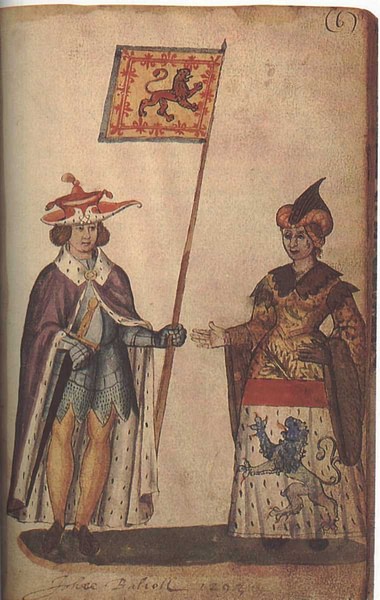
On 17 November 1292 CE Edward chose Balliol. The official reason was Balliol's closer proximity to David I in terms of descent. More practical reasons were because he was the most anglicised of the two main candidates and the weaker, meaning he could be more easily manipulated. Balliol swore fealty to Edward, and ten days later, he was inaugurated as King of Scotland on 30 November 1292 CE at Scone Abbey. Formal homage to Edward was paid by the new king on 26 December before an audience of 23 Scottish lords. John was warned by Edward to rule justly or face direct intervention in his kingdom. John at least had the support of the powerful Comyns, but at the same time, the Bruces and their supporters had not gone away, and continuing to believe in their right to rule, Scotland could certainly not be described as a unified kingdom.
As it turned out, the Scots themselves grew tired of Balliol's ineffective responses to Edward's domination. In 1294 CE John was obliged by Edward I to provide both cash and troops for English armies fighting in France, and these taxes were deeply unpopular. Another bone of contention was Edward's insistence that appeals from Scottish court cases be held at Westminster. John was even obliged to visit Westminster in person to explain some of his decisions as king. Now it was patently obvious that Edward I was really ruling Scotland, and open rebellion was in the air. In late 1295 CE, a regency council of 12 discontented nobles established a new government, perhaps entirely independent of John. This council, and therefore Scotland, formally allied itself with Philip IV of France (r. 1285-1314 CE) in February 1296 CE, the first move in what became known as the 'Auld Alliance'. King John, with not much choice in the matter and also being a landowner in France, renounced his fealty to Edward I in April 1296 CE. The Bruces did not support this rebellion against Edward I's overrule.
The English king responded emphatically to Scottish disobedience by forming a new army which he led in person to Berwick, the force totalling 25,000-30,000 men. Berwick was taken on 30 March 1296 CE, and many men, women, and children were massacred. Edward, earning the nickname 'the Hammer of the Scots', was now intent on total conquest, and by June he had gone a long way to achieving his goal. All the major Scottish castles were captured, and Balliol lost the Battle of Dunbar on 27 April 1296 CE. The Scottish king fled to Angus but surrendered on 2 July.
In a public ceremony on 8 July, John had his crown confiscated and the royal insignia stripped from his robes. As a consequence, the now ex-king gained the inglorious nickname of Toom Tabard or 'Empty Coat'. Balliol and his son Edward were then obliged to spend the next three years in the Tower of London. Following intervention from the Pope, John was finally allowed his freedom under papal supervision at Avignon and then to retire to the family estates in France. In his place, three English barons were nominated to rule Scotland, and Edward even stole the Scottish regalia and the Stone of Scone (aka Stone of Destiny) which was a symbol of the Scottish monarchy, relocating it to Westminster Abbey and placing it under the coronation chair. As far as Edward was concerned, Scotland was now a province of England.
Features of John's Reign
Alexander III had ruled with some success, expanding Scotland to its greatest territorial extent in the medieval period so far and overseeing a period of relative stability and prosperity. John, then, had a lot to live up to if he was to match what has often been termed a 'Golden Age' of Scottish history. John strengthened the role of the Scottish parliament in government and created three new sheriffdoms in the highlands (Kintyre, Lorn, and Skye). Evidence of trade is seen in 1293 CE when John granted safe conduct to merchants from Amiens where the Balliols had extensive estates. One of the most lucrative products these merchants brought was woad-dye with its distinctive blue colour. Really, though, John's reign was too short and too unstable to make any lasting impact.
Death & Successors
Despite Edward I's best efforts, Scotland was never quite subdued, and more rebellions followed, notably the uprising led by William Wallace (c. 1270-1305 CE) and Sir Andrew Moray of Bothwell. The rebels won a famous victory in September 1297 CE at the Battle of Stirling Bridge, but Edward, leading his army in person, won another encounter in July 1298 CE at the Battle of Falkirk where 20,000 Scots were killed. Edward then sent more armies in 1301 and 1303 CE, recovering Stirling Castle in the process. In 1305 CE Wallace was finally captured in Glasgow and then executed as a traitor in London. Still, in February 1306 CE, the Scots continued to rally around their figurehead, Robert the Bruce (b. 1274 CE), the grandson of John Balliol's rival for the throne back in 1292 CE. Robert denounced John Balliol as a puppet of Edward I and declared himself king; he would go on to rule Scotland until 1329 CE. John, meanwhile, continued to call himself 'King of the Scots' while he resided in his family castle at Picardy, a delusion he carried with him to the grave when he died in either April 1313 or the first days of 1315 CE.
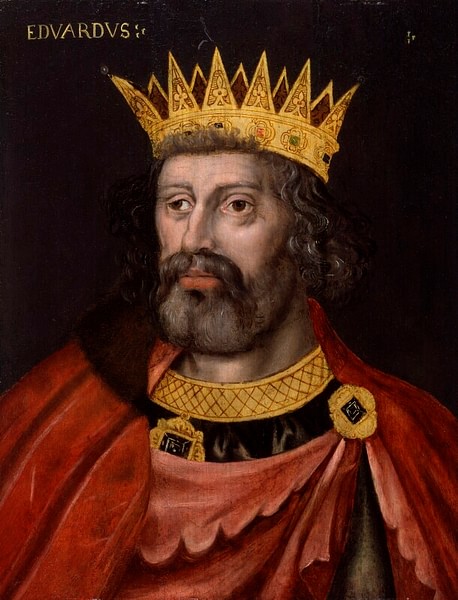
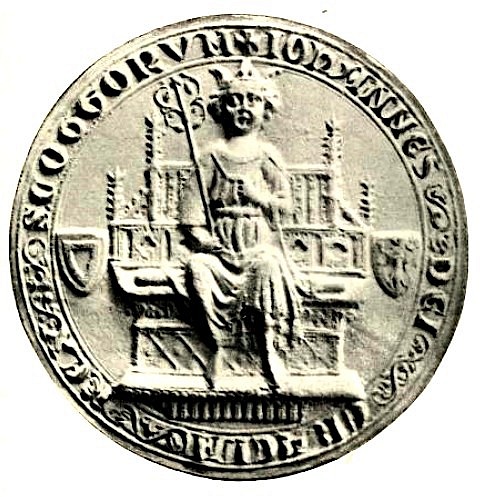
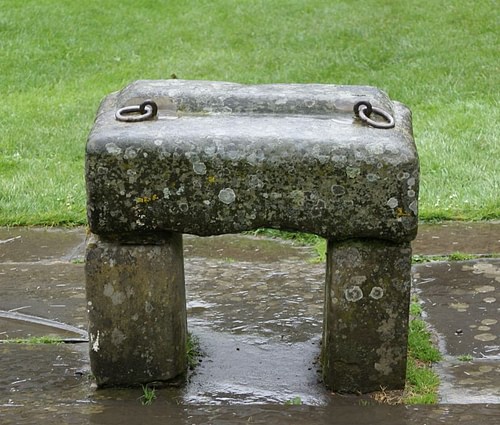

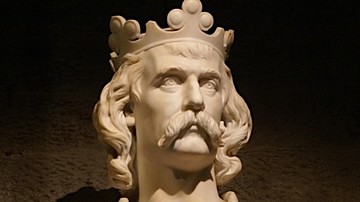
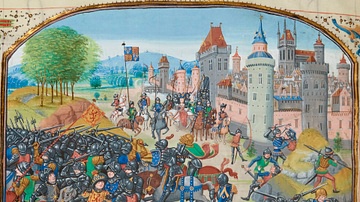

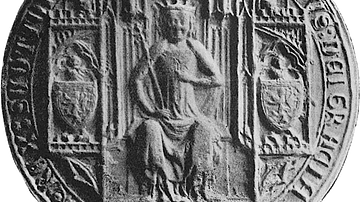




![Application of John H. Muirhead, M.A., Snell Exhibitioner, Balliol College, Oxford, for the Professorship of Classical Literature in University College, Toronto [microform]: With Testimonials](https://m.media-amazon.com/images/I/41TDAr0+MWL._SL160_.jpg)
![Catalogue of Printed Books in Balliol College Library [by J. Rathbone].](https://m.media-amazon.com/images/I/51LfjtFESdL._SL160_.jpg)